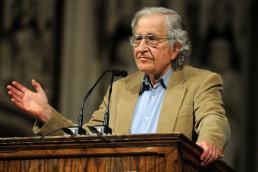
The Propaganda Model by Edward S. Herman and Noam Chomsky was made to explain how propaganda and systemic biases function in mass media. It was first presented in 1988 in their book “Manufacturing Consent: The Political Economy of the Mass Media”.
Ownership:
The profit seeking nature of dominant media corporations creates a bias as they try to address the interests of the audiences they are targeted at, thereby creating bias in the media.
In 19th Century a radical British press had emerged that addressed the concern of British workers, excessive taxes were put in place to then restrict newspaper ownership to what was considered the respectable wealthy, this changed the face of the press. There was still a degree of diversity that remained. In post war Britain, radical or worker-friendly papers such as Daily Herald, News Chronicle, Sunday Citizen and Daily Mirror regularly published articles which questioned the capitalist system. The authors of these were not restrained by corporations and so were free to criticize.
Advertising:
Many newspapers have to include advertising in order to cover production costs or else they have to increase the price. Lack of advertising funding on ‘peoples newspapers’ was a contributing factor to the loss of them in the nineteenth and twentieth centuries.
The news can be thought of as ‘filler’, the main purpose of the paper being to advertise, so some stories which may conflict the readers ‘buying mood’ may be excluded or only briefly mentioned. Therefore, though people are buying a newspaper, the advertising is the key point of the product, the news having only a marginal role.
Sourcing:
Due to limited funds and ability to place reporters all over the place, the majority of news comes from key places where news is guaranteed to be, e.g. The white house, 10 Downing Street, the Pentagon etc. Because of this, the news is dependent on pronouncements of “the prime ministers personal spokesperson” for government news and so are reluctant to make negative news on these places as they are threatened with the denial of access to the news they need.
Officials have and give the facts, reporters get them and journalists are supposed to write them with an uncritical attitude.
Flak:
Described as negative responses to a media statement or program. It can take any form. Business organisations often come together to form ‘flak machines’, an example being the US-Based Global Climate Coalition, formed by fossil fuel and automobile companies who attack the credibility of climate scientists and ‘scare stories’ about global warming to reduce the harm to their own businesses.
Flak is characterised by large efforts to manage public information by discrediting organisations or individuals who disagree with or create doubt on prevailing assumptions.
Anti-Communism and Fear:
“So I think when we talked about the “fifth filter” we should have brought in all this stuff — the way artificial fears are created with a dual purpose… partly to get rid of people you don’t like but partly to frighten the rest.
Because if people are frightened, they will accept authority” – Noam Chomsky
Fear, often of the enemy or an evil dictator is used in reporting often to control the audience. For example, British tabloid headlines “smash Saddam” or “Clobba Slobba”. These themes extend to mainstream reporting of environmentalists as Eco-terroritsts. There have also been articles accusing non-violent groups of stocking up on CS gas and Stun guns.
Public fear and hatred of groups that pose potential threat is exploited, whether that fear is real, exaggerated or imagined.Communism and socialism were once portrayed as endangering freedom of speech, movement and the press. Since the end of the Cold War, Chomsky argues that anticommunism was replaced by the ‘war on terror’ as the major social control mechanism.